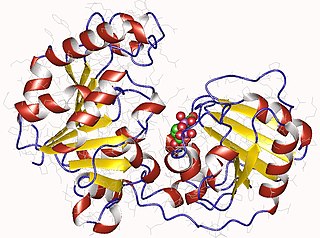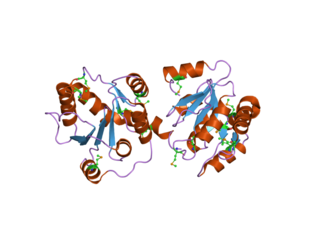
Gilbert syndrome (GS) is a syndrome in which the liver of affected individuals processes bilirubin more slowly than the majority. Many people never have symptoms. Occasionally jaundice may occur.
Glucuronidation is often involved in drug metabolism of substances such as drugs, pollutants, bilirubin, androgens, estrogens, mineralocorticoids, glucocorticoids, fatty acid derivatives, retinoids, and bile acids. These linkages involve glycosidic bonds.

Glucuronic acid is a uronic acid that was first isolated from urine. It is found in many gums such as gum arabic, xanthan, and kombucha tea and is important for the metabolism of microorganisms, plants and animals.

Uridine 5'-diphospho-glucuronosyltransferase is a microsomal glycosyltransferase that catalyzes the transfer of the glucuronic acid component of UDP-glucuronic acid to a small hydrophobic molecule. This is a glucuronidation reaction.

UDP-glucuronosyltransferase 1-1 also known as UGT-1A is an enzyme that in humans is encoded by the UGT1A1 gene.

UGT2B7 (UDP-Glucuronosyltransferase-2B7) is a phase II metabolism isoenzyme found to be active in the liver, kidneys, epithelial cells of the lower gastrointestinal tract and also has been reported in the brain. In humans, UDP-Glucuronosyltransferase-2B7 is encoded by the UGT2B7 gene.

UDP-glucuronosyltransferase 1-6 is an enzyme that in humans is encoded by the UGT1A6 gene.

UDP-glucuronosyltransferase 1-10 is an enzyme that in humans is encoded by the UGT1A10 gene.

UDP-glucuronosyltransferase 2B15 is an enzyme that in humans is encoded by the UGT2B15 gene.

UDP-glucuronosyltransferase 1-4 is an enzyme that in humans is encoded by the UGT1A4 gene.

UDP glucuronosyltransferase 2 family, polypeptide B4, also known as UGT2B4, is an enzyme that in humans is encoded by the UGT2B4 gene.

UDP-glucuronosyltransferase 2B17 is an enzyme that in humans is encoded by the UGT2B17 gene.
UDP glucuronosyltransferase 1 family, polypeptide A cluster (UGT1A) is a human gene locus which includes several UDP glucuronosyltransferases.

UDP-glucuronosyltransferase 2B10 is an enzyme that in humans is encoded by the UGT2B10 gene. It is responsible for glucuronidation of nicotine and cotinine.

UDP-glucuronosyltransferase 1-5 is an enzyme that in humans is encoded by the UGT1A5 gene.

UDP-glucuronosyltransferase 1-9 is an enzyme that in humans is encoded by the UGT1A9 gene.

UDP-glucuronosyltransferase 1-8 is an enzyme that in humans is encoded by the UGT1A8 gene.

UDP glucuronosyltransferase 2 family, polypeptide B1, also known as UGT2B1, is an enzyme that in humans is encoded by the UGT2B1 gene.

UDP glucuronosyltransferase 2 family, polypeptide A2, also known as UGT2A2, is an enzyme that in humans is encoded by the UGT2A2 gene.

UDP glucuronosyltransferase 1 family, polypeptide A7 is a protein that in humans is encoded by the UGT1A7 gene.










